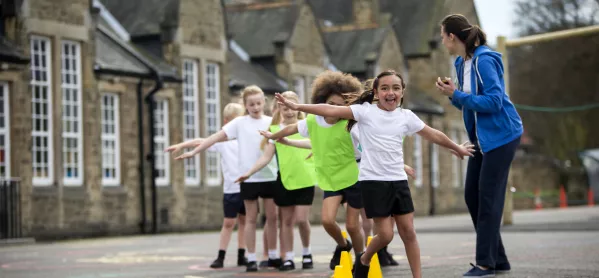6 steps to help primary PE recover from Covid lockdown

PE during the Covid pandemic has very much been a textbook case of crisis versus opportunity. Health and wellbeing have been a priority, especially given extended periods of lockdown, and, in many ways, it was a refreshing change to be outdoors for PE and adopting a “back to basics” approach.
Since pupils returned to school buildings in August 2020 - for a time - PE has been outdoors, no matter what. In primary schools, outdoor facilities are typically tired and in need not only of an upgrade but, in many cases, also a full replacement. Bumpy, uneven, hard playground surfaces are unfortunately not conducive to the highest-quality learning experiences. And Scotland’s unpredictable weather has also been a big challenge for PE in the Covid-recovery phase.
While our pupils were largely unfazed by the wet conditions, the weather presented a huge challenge for primary school teachers leading PE outdoors, especially in the winter months. With no guidance or directives on what should happen if the conditions were deemed unsuitable for outdoor learning, the end result was that if PE wasn’t to take place outdoors, there was the strong possibility that PE wouldn’t take place at all.
Covid: Is PE the most important school subject of all?
After lockdown: ‘Football helps pupils to face the challenges of Covid’
One positive from Covid? Pupils arriving in PE kit
Fortunately, having a PE specialist in our school meant that these challenges were met head-on and addressed. We embraced DIY and spray-painted courts and running areas to create our own outdoor court and running track, and identified fun and engaging activities suited to taking place outdoors. Activities such as orienteering, parkour, athletics and pupil-led playground games developed core skills, with minimal equipment but maximum engagement. Younger pupils explored moving in different ways and embraced the freedom and space to play outdoors that they had previously been denied.
We braved the weather as much as we could, but when heavy rain, ice and snow made outdoor conditions unsafe, we identified (fully risk-assessed) “in-class alternatives”, incorporating skills such as balance, coordination, rhythm and fine motor skills, as well as object-control activities and target throwing.
We were fortunate where others were not. Having a PE teacher with the expertise, experience and confidence to be able to address the challenges was key to PE remaining a source of fun and learning, even amid the ever-changing challenges of Covid, being outdoors and the limited guidance from local or national sources.
The past year has highlighted that, pre-pandemic, primary PE was badly neglected. Now is the time to give it the boost it needs, in order to provide quality and meaningful learning experiences and, ultimately, improve the health, wellbeing and physical literacy of our young people.
How to boost primary school PE after Covid lockdown
Here are my six steps to Covid recovery for primary PE:
1. Wider recognition and promotion of PE as an educational entity, distinct from sport and physical activity, with a focus on developing physical literacy and national PE ”broad general education” benchmarks.
2. The setting up of a PE network for primary teachers in each local authority to allow schools to collaborate, plan and devise a consistent approach for teaching high-quality physical education in primary schools.
3. A review and upgrade of all outdoor school facilities to allow for safe, high-quality learning experiences to take place.
4. An audit of PE equipment across authorities, and the provision of funding and support to ensure that all schools have access to appropriate PE resources either via funding or a central resource bank.
5. Access to PE-specific professional learning to help improve the skills and build the confidence of class teachers responsible for PE.
6. Detailed guidance on how PE can take place safely indoors in the event of another wave of Covid, taking into account issues such as social distancing, ventilation and maximum participant numbers.
Dominic Tollan is a PE teacher and editor of the SATPE (Scottish Association of Teachers of Physical Education) Journal
You need a Tes subscription to read this article
Subscribe now to read this article and get other subscriber-only content:
- Unlimited access to all Tes magazine content
- Exclusive subscriber-only stories
- Award-winning email newsletters
Already a subscriber? Log in
You need a subscription to read this article
Subscribe now to read this article and get other subscriber-only content, including:
- Unlimited access to all Tes magazine content
- Exclusive subscriber-only stories
- Award-winning email newsletters